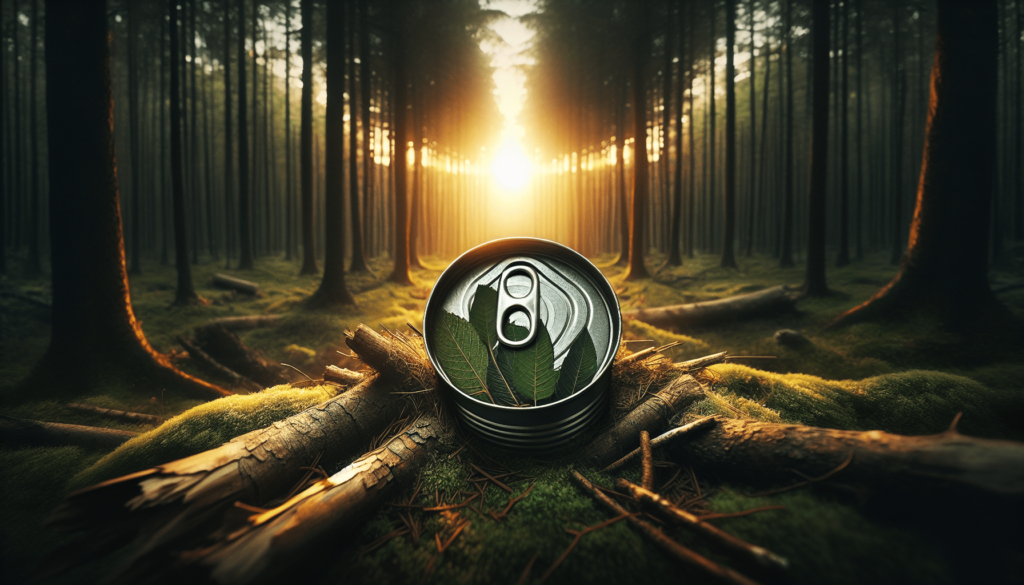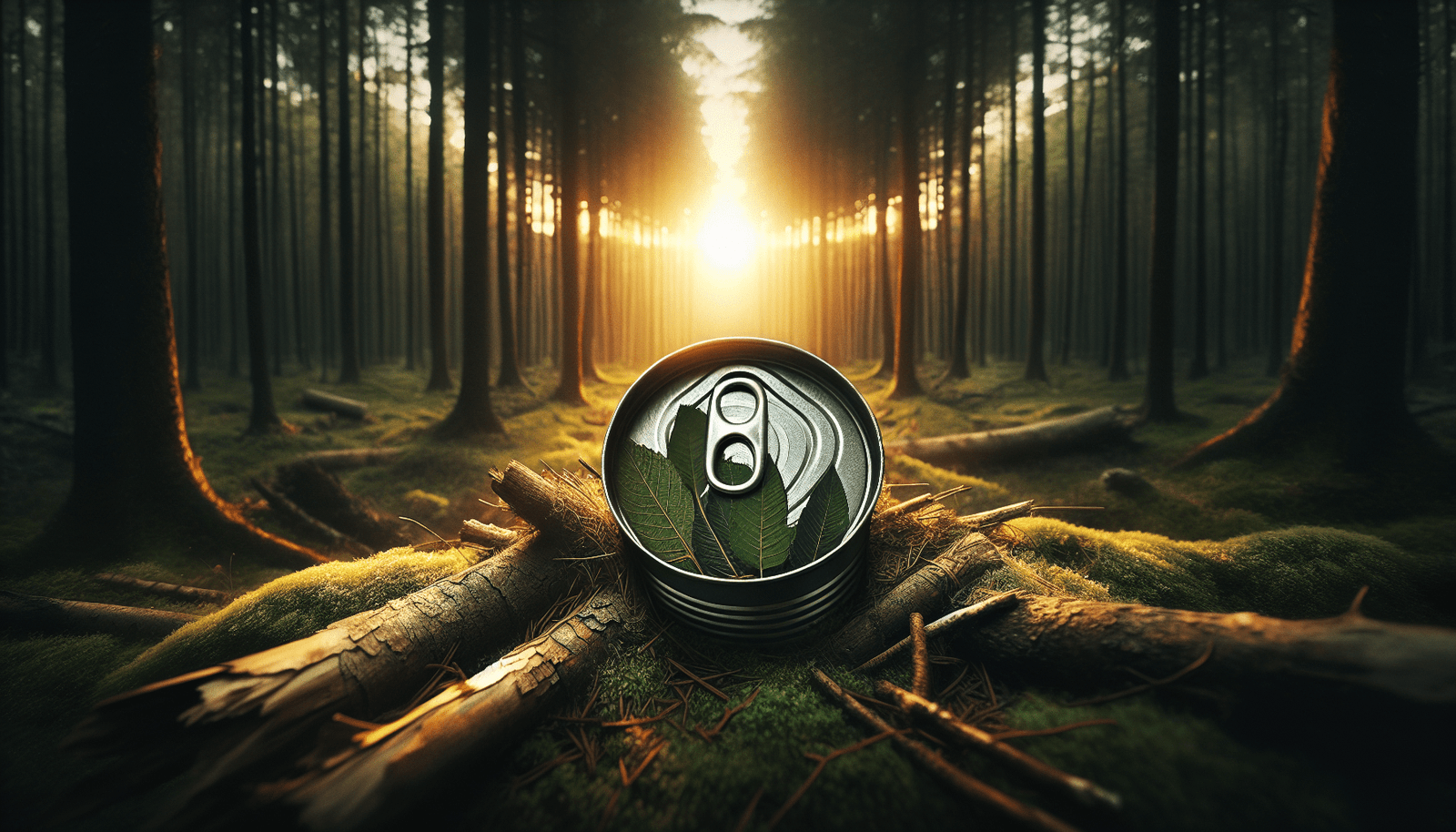Are you ready to discover the secrets of using everyday items for wilderness survival? Look no further than “The Survivalist Handbook” where we dive into the world of unconventional gear. Whether it’s repurposing a soda can into a makeshift stove or transforming a plastic bag into a waterproof shelter, these tips will surely come in handy during your outdoor adventures. Get ready to unlock a whole new level of resourcefulness and adaptability as you learn how to make the most out of the items you already have on hand. Wilderness survival has never been so inventive!

Water Bottles
When it comes to wilderness survival, one of the most important things you need is a reliable source of water. While you may have packed a water bottle for your adventure, there are also several ways you can repurpose it in case of emergencies.
Collect and store water
Your water bottle can be used to collect and store water from various sources. If you come across a stream or river, you can fill your bottle and have a supply of water for drinking, cooking, and cleaning. Make sure to filter the water if it’s not from a trusted source to remove any harmful bacteria or contaminants.
Create a makeshift fishing bobber
If you find yourself near a body of water and in need of food, your water bottle can come to the rescue. By partially filling the bottle with water, you can create a makeshift fishing bobber. Attach a fishing line and hook to the bottle and float it in the water to attract fish. This can increase your chances of catching a meal and sustaining yourself in the wilderness.
Build a solar still
In a survival situation, finding clean drinking water can be a challenge. However, with the help of your water bottle, you can build a solar still to extract water from moist soil or vegetation. Dig a hole in the ground, place your water bottle in the center, and cover the hole with a clear plastic sheet. As the sun heats the soil and vegetation, the moisture will evaporate and condense on the plastic sheet, eventually dripping into your water bottle.
Trash Bags
Trash bags may not seem like a typical survival item, but they can be incredibly useful in the wilderness. These versatile bags can serve multiple purposes and help you stay prepared.
Create an emergency shelter
In a survival situation, having a shelter to protect yourself from the elements is crucial. A trash bag can be used to create a makeshift shelter by tying it between two trees or securing it with rocks. Cut a small hole for ventilation and crawl inside to stay dry and protected from wind and rain. It’s a quick and effective way to have a temporary shelter until you can find a more permanent solution.
Collect rainwater
When water is scarce, collecting rainwater becomes essential. Use a trash bag to create a rain catchment system by tying it between trees or attaching it to a branch. As the rain falls, it will collect in the bag, providing you with a source of water for drinking, cooking, and hygiene.
Carry and protect your gear
Having a durable and waterproof bag to carry your gear is crucial in the wilderness. Use a sturdy trash bag to create a makeshift backpack by tying the handles together and securing them with knots or cordage. This will help keep your belongings organized, dry, and easily transportable as you navigate through the wilderness.
Duct Tape
Duct tape is a staple in any survival kit, thanks to its versatility and strength. When faced with unexpected challenges in the wild, duct tape can be a lifesaver.
Repair damaged gear
In the wilderness, your gear can experience wear and tear or even sustain damage from the elements. Duct tape can be used to repair torn clothing, footwear, or tents, ensuring that they remain functional and provide the necessary protection. Simply apply strips of duct tape to hold the damaged areas together temporarily until you can find a more permanent solution.
Create an improvised rope
If you find yourself in need of a strong cordage, duct tape can be transformed into an improvised rope. Tear long strips of duct tape and roll them tightly into a cord-like shape. Twist multiple strips together and secure the ends with additional layers of duct tape. This makeshift rope can be used for various tasks, such as building shelters, securing objects, or even creating traps for catching food.
Make a splint for injured limbs
Injuries can happen in the wilderness, and having the ability to immobilize a fractured or sprained limb is crucial for your safety. Duct tape can be used to create a splint by securing sturdy branches or sticks to the injured area. Wrap several layers of duct tape around the splint and the limb to provide support and immobilization until medical help can be reached.
Aluminum Foil
Aluminum foil is commonly used for cooking and food storage, but it also has several survival applications in the wilderness. This lightweight and versatile material can prove to be invaluable in certain situations.
Cook food over a fire
When it comes to preparing meals in the wilderness, aluminum foil can be a game-changer. Wrap food, such as fish or vegetables, in aluminum foil and place it near hot coals or on a grill over a fire. The foil serves as a heat conductor, helping to cook your food evenly and retain its moisture. This method is not only practical but also allows for easy cleanup.
Signal for help
If you find yourself in a dangerous situation and in need of rescue, aluminum foil can be used to create a reflective signaling device. Tear a large piece of foil and shape it into a flat surface. Use the sunlight to reflect the light towards potential rescuers, increasing your chances of being spotted from a distance.
Create a makeshift cup or bowl
Having a container to drink from or eat out of is essential for your survival. Aluminum foil can be shaped and folded to create a makeshift cup or bowl. Simply mold the foil into the desired shape and ensure the edges are securely folded to prevent leaks. This improvised container can be used for drinking water, cooking meals, or collecting food.

Plastic Bags
Plastic bags are lightweight, compact, and can serve a variety of purposes in a survival situation. Don’t overlook these everyday items when it comes to your wilderness survival gear.
Collect and store food
In the wild, it’s essential to gather and store food to sustain yourself. Plastic bags can be used to collect a variety of edible plants, berries, nuts, or even small game. Ensure that you properly identify and prepare any food from the wild before consuming it. Once collected, seal the plastic bag tightly to prevent spoilage or contamination.
Create a waterproof barrier
When faced with rain or wet conditions, keeping your gear dry becomes a top priority. Place your important belongings, such as matches, electronic devices, or extra clothes, in a plastic bag and seal it tightly to create a waterproof barrier. This will ensure that your items stay dry and functional even in the wettest conditions.
Keep gear organized and dry
In the wilderness, having a well-organized and accessible gear system is crucial. Use plastic bags to separate and protect different items within your backpack. Categorize your gear, such as clothing, food, or toiletries, and place them in separate plastic bags to prevent cross-contamination and keep everything organized. Additionally, use plastic bags to store wet or dirty items separately, preventing them from affecting the rest of your gear.
Bandanas
Bandanas are lightweight and versatile pieces of fabric that can serve multiple purposes in a survival situation. If you have a bandana with you, it can become an incredibly useful tool for various tasks.
Filter water
Access to clean drinking water is essential for survival. Use a bandana to filter out debris and sediment from collected water by creating a makeshift filtration system. Fold the bandana several times to create multiple layers, then pour the water through it into a clean container. This will help remove large particles and make the water safer to drink.
Provide protection from the sun and wind
The sun and wind can be harsh in the wilderness, so it’s crucial to protect yourself from their effects. Use a bandana as a head covering to shield your face, scalp, and neck from the sun’s rays or as a makeshift face mask to protect yourself from dust and wind. Additionally, wetting the bandana and wearing it around your neck can provide a cooling effect in hot conditions.
Create a sling for injured arms
In the unfortunate event of an arm injury, immobilizing the limb is essential for pain management and avoiding further damage. A bandana can be used to create a makeshift sling by tying two ends of the fabric around the neck and supporting the injured arm. This makeshift sling will help stabilize the arm and prevent unnecessary movement until medical help can be reached.
Tin Cans
Tin cans may seem like disposable items, but in a survival situation, they can prove to be incredibly useful. Their durability and versatility make them a valuable resource in the wilderness.
Cook food over a fire
One of the most practical uses for tin cans in survival situations is cooking food. Clean the can thoroughly and place it near a fire or on hot coals to heat up your meals. Tin cans can withstand high temperatures and distribute heat evenly, making them ideal for cooking a variety of foods.
Make a makeshift stove
If you’re in need of a more substantial cooking setup, tin cans can be repurposed to create a makeshift stove. Cut several small air holes around the bottom of a tin can, place fuel such as twigs or small pieces of wood inside, and light it. The tin can will act as a stove, providing a stable cooking surface and containing the fire.
Collect and boil water
In a survival situation, finding a reliable source of clean water is crucial. Tin cans can be used to collect water from streams or other sources and then boil it, making it safe for drinking. Boiling water helps kill harmful bacteria and parasites, reducing the risk of waterborne illnesses.
Paracord
Paracord, also known as parachute cord, is a lightweight and incredibly strong rope that can be an essential tool in the wilderness. Its versatility makes it a must-have item for any survivalist.
Build a shelter
A shelter is crucial for protection from the elements in a survival situation. Paracord can be used to create a sturdy and secure shelter by tying branches, tarp, or other materials together. Its strength and durability will help ensure that your shelter withstands wind, rain, and other challenging conditions.
Create a makeshift clothesline
Maintaining proper hygiene in the wilderness is important for your overall well-being. Paracord can be used as a clothesline to dry wet clothes or hang items such as towels, socks, or gloves. Simply tie the paracord between two stable trees and use clothespins or knots to secure your items. This will help prevent moisture buildup and keep your gear dry.
Make traps for catching food
In a survival situation, finding food can be challenging. Paracord can be used to create various types of traps and snares to catch small game, increasing your chances of obtaining a much-needed meal. Research and learn about different trapping techniques before attempting to create a trap using paracord or any other materials.
Coffee Filters
Coffee filters may seem like a luxury item in the wilderness, but they have practical uses beyond making your morning brew. Don’t overlook these handy filters when it comes to survival.
Filter water
Access to safe drinking water is crucial for survival. Coffee filters can be used to remove sediment and some bacteria from collected water. Secure a coffee filter over a container and pour the water through it, allowing the filter to catch impurities and provide cleaner water for drinking or cooking.
Create tinder for starting fires
Starting a fire is fundamental for survival, whether it’s for warmth, cooking, or signaling for help. Coffee filters can be used as excellent tinder for starting fires as they catch sparks easily. Tear or crumble the filter into small pieces and use them to catch a spark from a fire starter or flint and steel.
Protect electronic devices from moisture
If you’re carrying electronic devices such as phones, GPS devices, or cameras in the wilderness, protecting them from moisture is essential. Wrap the devices in a coffee filter before storing them in a waterproof container or plastic bag. The coffee filter will help absorb any moisture that may be present, keeping your devices dry and functional.
Safety Pins
Safety pins are small and unassuming, but in a survival situation, they can be incredibly handy. These versatile little tools have multiple uses that can help you navigate the challenges of the wilderness.
Repair clothing or gear
In the wild, clothing and gear can easily get damaged or torn. Safety pins can be used to temporarily fix ripped seams or secure loose straps, ensuring that your gear remains functional. Simply thread the pin through the fabric, securing the damaged area and preventing further tearing.
Create a makeshift fishing hook
If you find yourself in need of food and lacking fishing gear, safety pins can be repurposed as makeshift fishing hooks. Remove the clasp from the pin, bend the remaining wire into a hook shape, and attach it to a fishing line or makeshift fishing pole. This improvised hook can increase your chances of catching fish and improving your survival prospects.
Secure bandages or splints
If you or someone in your group suffers an injury in the wilderness, having the proper supplies to secure bandages or splints is crucial. Safety pins can be used to secure and hold bandages in place and provide support to splints. Make sure to sterilize the pins before using them to reduce the risk of infection.
In conclusion, the wilderness can present unexpected challenges, but by repurposing everyday items, you can increase your chances of survival. Water bottles, trash bags, duct tape, aluminum foil, plastic bags, bandanas, tin cans, paracord, coffee filters, and safety pins are all examples of unconventional gear that can serve multiple purposes in a survival situation. By understanding how these items can be repurposed, you can be better prepared to handle unforeseen circumstances and thrive in the great outdoors. Remember, knowledge and resourcefulness are key in wilderness survival. Stay prepared, stay safe, and embrace the adventure!

